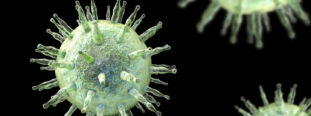ECTRIMS 2017: Tecfidera – Results from the real world
Highlights from the 7th Joint ECTRIMS-ACTRIMS MEETING, OCTOBER 25-28, Paris, France
Ten tips for taking Tecfidera
Take the My Voice survey
Tecfidera (dimethyl fumarate) is one of the most commonly prescribed medications to treat multiple sclerosis, and has been shown to be highly effective in two clinical trials. A recent analysis of these studies found that about 40% of people had no relapses or worsening disability in the first two years of taking the drug (Havrdova and colleagues. Eur J Neurol 2017;24:726-733). The risk of having a relapse has also been shown to remain low among people who stay on therapy over the longer term (Gold and colleagues, ECTRIMS 2017; abstract P661).
Trial results may not always reflect what goes on in the less rarefied air of the real world, so it’s useful to look at other studies presented at this year’s ECTRIMS congress to get a better feel for the drug.
One such study was ESTEEM, which collected data from about two thousand people treated at 380 MS clinics around the world (Giles and colleagues. ECTRIMS 2017; abstract P1163). Relapses rates were reduced by about 80% in the year after starting Tecfidera, even among those who had previously been taking an injectable drug. A separate analysis of ESTEEM found that people taking Tecfidera were one-third less likely to have a relapse compared to those on Copaxone, and were also more likely to keep taking their medication (Chan and colleagues. ECTRIMS 2017; abstract P1160).
Ten tips for taking Tecfidera
Staying on regular treatment and keeping with the program is often challenging for people with MS. The introduction of oral medications has helped, but remembering to take your pills once or twice a day can be difficult.
A common reason to quit is side effects. A group of seven MS clinics in Italy found that over a 16-month period, 12% of people on Tecfidera stopped taking their drug because of difficulties tolerating the drug (Mirabella and colleagues. ECTRIMS 2017; abstract P1168). Over the longer term, about 45% at the 8-year mark stop taking Tecfidera (Gold 2017). The options then would be either to switch to another treatment, which may cause problems of its own, or go off therapy altogether, which allows MS to continue unchecked.
So how can treatment be made easier?
The most common problems when taking Tecfidera are gastrointestinal upset (stomach pain, nausea, diarrhea), and flushing (feeling hot or red-faced). A recent study looked at ways to minimize side effects during Tecfidera so that treatment is more tolerable (Mayer and colleagues. Drug Saf 2017; epublished December 7, 2017).
So just in time for the holiday season, we’ve put together a list of Ten Tips for you when taking your Tecfidera.
- Know what to expect – and plan accordingly. Stomach upset and flushing are common in the beginning. But it’s important to realize that these will become less frequent and severe over time as you continue taking the drug.
- Start low. When you begin taking Tecfidera, you must start with half the usual dose, then work your way up to the full dose. For the first week or two, take 120 mg twice daily. As your body gets used to the drug, you can increase the amount until you’re taking the full dose of 240 mg twice daily.
- Go slow. When you’re ready to work your way up to the full dose, start by increasing the evening dose first. This may be easier because you will be taking the larger dose with the larger evening meal, and you can sleep through unpleasant drug effects that happen overnight. Step 1: 120 mg with breakfast and 120 mg with dinner. Step 2: 120 mg with breakfast, 240 mg with dinner. Step 3: 240 mg with breakfast, 240 mg with dinner (the full dose). Give your body time to adjust (a week or two) before you go on to the next step.
- Take Tecfidera with a full meal. This will settle your stomach and reduce your chance of experiencing nausea and diarrhea. High-fat, high-protein meals will work better, e.g. eggs and bacon or yogurt for breakfast, meats or cheese for dinner. Starchy foods (bread, pasta, potatoes/rice, etc.) are less effective.
- Try taking Tecfidera with applesauce, yogurt or peanut butter. A spoonful with your pills will help the medicine go down.
- Healthy eating helps. High fats can be unhealthy, so look for healthy-fat alternatives, such as avocado and nut butters
- Take a low dose of Aspirin before you take Tecfidera. This will help to prevent flushing. A low dose of Aspirin is 81 mg (check the label for the low-dose pills; or split the usual 325-mg tablet into four pieces and take one piece). Take the Aspirin about 30 minutes before you take Tecfidera.
- Stomach remedies can prevent or relieve stomach symptoms. A variety of non-prescription stomach medicines can be helpful for stomach pain, nausea and diarrhea. These include Zantac (ranitidine) or Pepcid (famotidine); Losec/Prilosec (omeprazole) or Prevacid (lansoprazole); Pepto-Bismol or Kaopectate (bismuth subsalicylate); Gravol (dimenhydrinate); and Imodium (loperamide). These medicines can be taken either before Tecfidera to prevent problems, or afterward if you develop symptoms. Talk to your MS nurse or pharmacist about these (or any) medications before you take them.
- Try to stop smoking. A recent study found that people who smoked were more likely to suffer from stomach symptoms while on Tecfidera (another reason for this New Year’s resolution to quit) (Pellegrini and colleagues. ECTRIMS 2017; abstract P794).
- Moderate your alcohol consumption. Alcohol will irritate your stomach on its own, and drinking may make your stomach problems worse (Pellegrini 2017).
To this list we might add a final item: remember why you’re taking your medication. Flushing and stomach symptoms are unpleasant, but don’t lose sight of the larger goal: to control your MS, and reduce the risk of developing disability over the longer term.
MY VOICE – Tell us about your experience with Tecfidera
If you’re taking Tecfidera for your MS, we’d like to hear what you think about this medication. Please complete the survey below.
Une version française de cet article et sondage sont aussi disponible.
Share this article
Facebook Twitter pin it! Email
Related Posts
Back






